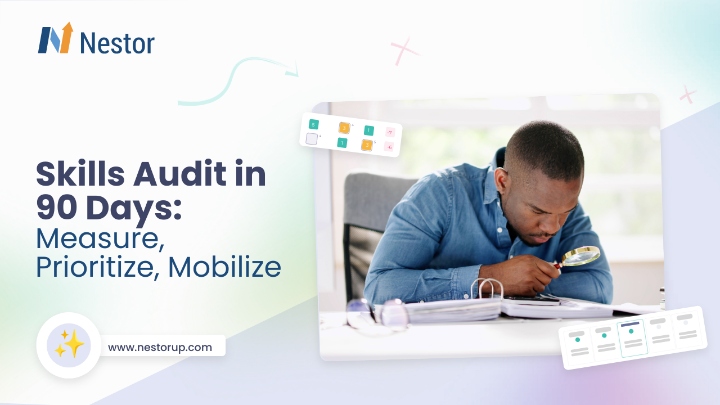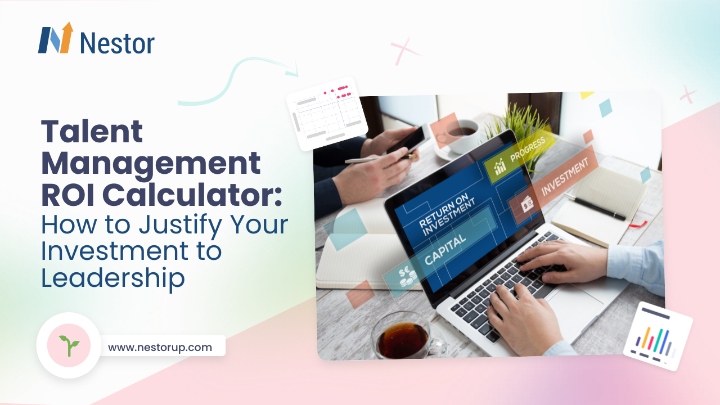Uplifting Your Workforce with Internal Gigs and Skills-Based Solutions
14 min read

Have you ever wondered about a strategic way to increase internal mobility and boost employee retention within your organization? Look no further than the rising trend of internal gigs.
Businesses are always on the lookout for strategies on how they can transform themselves – the best ways to create more flexibility, speed, innovative products and services. This change is facilitated by an innovative strategy to talent management: internal gigs. Many of these positions or assignments are short-term in nature, and they allow employees to expand their job experiences, take on responsibilities they might not have on a routine basis, and help the company in new ways. In contrast to a rather closed and compartmentalized structure, internal gigs are blurring the boundaries between departments and creating a more integrated organizational culture.
But, the internal gigs have the echo effect which is not only experienced by the employees. Firms that have adopted this revolutionary change are already reaping their benefits ranging from better ways of using talent, internal mobility, and innovation. In fact, a research conducted by SHRM revealed that organizations that implemented a talent marketplace report more than a 60% boost in internal sourcing.
Internal gigs are gradually being applied as one of the most effective techniques to help organizations prepare the talent pool for future developments, enhance employees’ motivation, and pursue a long-term business development strategy. In this article, you will be introduced to internal gigs and the advantages that they bring to your employees as well as to your organization’s pocket, and how to set up internal gigs correctly.
What Are Internal Gigs?
Imagine you’re a software engineer at a tech company. Your day-to-day work revolves around developing new features for your company’s flagship product. But one day, you hear about an opportunity to work on a project for the finance team – they’re looking to create a new analytics dashboard, and they need someone with your technical expertise to help out.
This is an internal gig. It’s a chance for you to apply your skills in a new context, collaborate with a different department, and take on a challenge that’s outside of your usual responsibilities. And the best part? You get to do it all while still being part of the same company. Internal gigs can take many forms – from a marketing professional leading a social media campaign for the HR department to an HR specialist helping the sales team revamp their onboarding process.
The common thread is that these are short-term projects or roles that allow employees to venture beyond their typical job descriptions and contribute to the organization in dynamic ways. The beauty of internal gigs lies in their ability to create a more agile, responsive, and cross-functional work environment. By tapping into the diverse skills and expertise of their workforce, organizations can quickly assemble teams to tackle emerging challenges or explore new initiatives, without the need for extensive onboarding or external hires.
The Benefits of Internal Gigs for Employees
It remains a fact that today, employees expect more flexibility, self-organizing work, and a chance to develop themselves; internal gigs become a perfect answer to that. Here’s a closer look at the many ways in which internal gigs can benefit both employees and organizations:
Skill Development: One of the primary benefits of internal gigs is the chance for employees to acquire new skills and enhance their existing capabilities. Through challenging themselves and doing things that might not necessarily come naturally to them or be within their competency level, employees can gain useful experience and become more versatile contributors to the organization. This skill diversification not only benefits the individual but also strengthens the overall talent pool within the company.
Career Growth: Participating in internal gigs allows employees to explore different roles and departments within the company, gaining valuable insights and experiences that can inform their long-term career aspirations. Such exposure to the other functions and tasks may have an added advantage in opening up new opportunities for career and growth. Employees can use these gigs as stepping stones to transition into new roles or identify areas of the business that align best with their interests and strengths.
Job Satisfaction: Variety is the spice of life, and internal gigs can play a crucial role in combating employee burnout and keeping them engaged. By offering a break from routine tasks and the opportunity to work on stimulating, cross-functional projects, internal gigs can reinvigorate employees and improve their overall job satisfaction. This, in turn, can lead to increased productivity, higher retention rates, and a more positive organizational culture.
Networking Opportunities: Internal gigs create a platform for employees to build connections and across different departments and teams. These cross-functional collaborations can lead to valuable networking opportunities that may help in mapping one’s path while within the company. Using these connections, employees can look for guidance, learn what it is like in other operational branches of the company, or even apply for a transfer to another position within the company.
The Benefits of Internal Gigs for Companies
While the advantages of internal gigs for employees are well-documented, the real game-changer lies in the substantial benefits they offer to the organizations that implement them. By embracing internal gig programs, companies can transform their talent management strategies and drive long-term success.
Talent Utilization: By tapping into the diverse skills and expertise of their existing employees, organizations can utilize the vast potential of the human resource using skills and experience within the existing workforce to overcome challenges in their operating environment and to capitalize on opportunities. Rather than relying solely on external hires, internal gigs allow companies to optimally deploy their workforce and ensure that the right skills are applied to the right projects.
Internal Mobility: Internal gigs facilitate a more fluid and dynamic career progression within the organization. Employees can explore different roles and departments, gaining valuable cross-functional experience. This not only enhances their skills but also helps companies fill critical positions more efficiently, as they have a deeper understanding of their internal talent pool. By promoting internal mobility, organizations can reduce the time and costs associated with external hires and ensure a smoother succession planning process.
Innovation and Agility: When employees from various backgrounds and perspectives come together to work on internal gigs, it sparks creativity and fosters a culture of innovation. Interdisciplinary knowledge exchange and the opportunities to unite connected but specialized teams can help organizations be more flexible in response to market shifts and further outcompete rivals.
Employee Retention: Offering internal gig opportunities can be a powerful retention strategy, as it demonstrates the company’s commitment to employee growth and development. By providing opportunities for skill enhancement, career exploration, and greater job satisfaction, organizations can keep their top talent engaged and reduce the cost associated with external hires. Retaining skilled and experienced employees is crucial for maintaining institutional knowledge and ensuring the continuity of critical business functions.
Cost-Effectiveness: Implementing an internal gig program can be a cost-effective approach to managing workloads and resources. By leveraging existing employees, companies can avoid the expenses associated with onboarding and training new hires, while also reducing the need for external contractors or consultants.
79% of L&D leaders agree it is less expensive to reskill a current employee than to hire a new one, while 54% agree that internal mobility has become a higher priority at their organization since COVID-19.
— LinkedIn’s Workplace Learning Report
Implementing a Successful Program for Internal Gigs
Unlocking the full potential of internal gigs requires a strategic, well-executed approach. While the benefits are clear, successfully implementing an internal gig program involves careful planning, stakeholder buy-in, and ongoing management. Here’s a comprehensive guide to help organizations implement a successful internal gig program:
Assess Needs and Opportunities
Begin by carefully examining your organization’s pain points, upcoming projects, and skill gaps. Where could internal gigs add the most value? Identify areas where additional expertise or cross-functional collaboration could drive meaningful impact.
- Conduct a thorough skills audit: Use surveys, interviews, and data analysis to understand the current skill distribution within your organization. This will help you identify areas of strength and potential gaps.
- Analyze upcoming projects and initiatives: Review your organization’s strategic plans and upcoming projects. Identify areas where additional support or specialized skills might be needed.
- Evaluate departmental needs: Reach out to department heads and team leaders to understand their specific challenges and where they could benefit from additional support or expertise.
- Consider market trends: Look at industry trends and emerging technologies. Are there areas where your organization needs to build capabilities to stay competitive?
This assessment will help you prioritize the most impactful gig opportunities and ensure they align with the company’s strategic objectives. It’s crucial to involve key stakeholders in this process to ensure buy-in and alignment across the organization.
Leverage Skills-Based Platforms like Nestor for Internal Gigs
Implementing a thriving internal gig program starts with a deep understanding of your workforce’s skills. Nestor can be a game-changer in this process.
- Skills visualization: Nestor helps organizations collect and visualize skills in real-time, providing a comprehensive view of the organization’s talent landscape. This visual representation can help identify clusters of expertise and potential skill gaps.
- Skill gap analysis: Use Nestor to identify areas where your organization lacks critical skills. This information can guide the creation of internal gig opportunities that address these gaps.
- Internal matching: Nestor’s algorithms can match employees with internal gig opportunities that align with their current skills and career aspirations. This increases the likelihood of successful placements and positive outcomes for both employees and the organization.
- Skill development tracking: Monitor how employees’ skills evolve as they participate in internal gigs. This data can help demonstrate the program’s impact on skill development and inform future talent development strategies.
- Emerging skill trends: Nestor’s AI-powered suggestions help identify emerging skill trends, allowing organizations to stay ahead of the curve in talent development. This information can guide the creation of forward-looking gig opportunities that prepare the organization for future challenges.
Set Clear Guidelines
Outline the expectations and parameters for internal gigs to ensure smooth implementation and avoid potential conflicts or misunderstandings.
- Time commitment: Clearly define how much time employees are expected to dedicate to gig projects. This could range from a few hours a week to full-time assignments for a set period.
- Compensation and recognition: Determine how employees will be compensated for gig work, especially if it’s outside their regular job duties. This could involve additional pay, bonuses, or other forms of recognition.
- Performance evaluation: Establish how gig work will be factored into an employee’s overall performance evaluation. Ensure that managers understand how to assess and credit gig contributions.
- Project selection criteria: Define how gig projects will be selected and approved. This might involve a review process to ensure alignment with organizational goals and resource availability.
- Skill requirements: Use Nestor’s dynamic skills taxonomies to accurately define the skills required for each gig. This ensures that both employees and managers have a clear understanding of what is required.
Clear guidelines are crucial for the smooth and effective implementation of the internal gig program. They help manage expectations, reduce potential conflicts, and ensure fair and consistent application of the program across the organization.
Secure Leadership Buy-In and Support
The success of an internal gig program often hinges on strong support from organizational leadership. Here are strategies to secure and maintain this crucial backing:
- Present a compelling business case: Use data from your needs assessment and industry benchmarks to demonstrate the potential benefits of an internal gig program. Highlight how it aligns with organizational goals, such as talent retention, skill development, and agility.
- Address concerns proactively: Anticipate potential concerns from leadership, such as impact on productivity or departmental resources. Come prepared with strategies to mitigate these risks.
- Regular updates: Commit to providing regular updates on the program’s progress, including metrics on participation, skill development, and impact on business objectives.
- Leadership participation: Encourage leaders to participate in the program, either by offering gig opportunities within their teams or by taking on gigs themselves. This sets a powerful example for the rest of the organization.
Develop a Strong Communication Strategy
Effective communication is key to driving awareness, understanding, and participation in the internal gig program.
- Launch campaign: Develop a comprehensive launch campaign to introduce the program to the organization. This might include company-wide announcements, informational sessions, and promotional materials.
- Success stories: Share success stories and case studies of employees who have benefited from participating in gigs. This can help inspire others and demonstrate the program’s value.
- Manager education: Develop specific communication and training materials for managers to help them understand their role in supporting the program and how to integrate gig work into their team’s operations.
- FAQ and resources: Create a comprehensive FAQ and resource center where employees can find answers to common questions about the program and how to participate.
- Feedback channels: Establish clear channels for employees to provide feedback on the program, report issues, or suggest improvements.
Promote and Encourage Participation
Active promotion and encouragement are crucial for driving participation in the internal gig program.
- Targeted outreach: Use Nestor to identify employees who might be a good fit for certain gigs based on their skills and career aspirations. Reach out to these employees directly to encourage them to apply.
- Career development integration: Integrate gig participation into career development discussions and plans. Help employees see how gigs can support their long-term career goals.
- Recognition and rewards: Develop a system to recognize and reward employees who actively participate in gigs. This could include highlighting their contributions in company communications or considering gig participation in promotion decisions.
- Skill development pathways: Use Nestor’s insights to create and promote skill development pathways that incorporate gig opportunities. Show employees how participating in certain gigs can help them build desired skills.
Provide Necessary Support and Resources
Ensure that employees have the support and resources they need to succeed in their gig assignments.
- Training and development: Offer training opportunities to help employees quickly ramp up on skills needed for gig assignments.
- Mentorship: Establish a mentorship program to support employees taking on new challenges through gigs.
- Technology and tools: Ensure that employees have access to the necessary technology and tools to effectively contribute to their gig projects, especially if working across departments.
- Time management support: Provide resources and guidance on effective time management to help employees balance their regular responsibilities with gig work.
Monitor, Evaluate, and Iterate
Continuous monitoring and evaluation are crucial for the long-term success of the internal gig program.
- Define key metrics: Establish clear metrics to measure the program’s success, such as participation rates, skill development progress, employee satisfaction, and impact on business outcomes.
- Regular reviews: Conduct regular reviews of the program’s performance against these metrics. Use Nestor’s comprehensive analytics and reports on skill development and gig participation to inform these reviews.
- Feedback collection: Regularly collect feedback from gig participants, project leaders, and managers to identify areas for improvement.
- Continuous improvement: Use the insights gained from monitoring and feedback to continuously refine and improve the program. Be prepared to make adjustments to policies, processes, or the types of gigs offered based on this feedback.
- Benchmarking: Compare your program’s performance against industry benchmarks and best practices. Look for opportunities to innovate and stay ahead of trends in internal talent mobility.
- Board reporting: Prepare regular updates for senior leadership and the board, highlighting the program’s impact on key organizational goals such as talent retention, skill development, and agility.
Implementing an internal gig program is a complex undertaking that requires careful planning, strong leadership support, and ongoing management. However, with a strategic approach and the right tools like Nestor, organizations can create a thriving internal gig ecosystem that benefits both employees and the company as a whole. By fostering a culture of continuous learning, cross-functional collaboration, and internal mobility, companies can build a more agile, skilled, and engaged workforce. Organizations that successfully implement and nurture these programs will be well-positioned to thrive in the dynamic and unpredictable business environment of the future.
Final Thoughts
As we’ve explored throughout this article, internal gig programs represent a powerful tool for both employee development and organizational success. By embracing this innovative approach, companies can unlock a wealth of benefits for both their workforce and their bottom line. But what does this mean for you and your organization?
Consider this: How would your own career path change if you had the opportunity to explore different roles and projects within your organization? Would you discover hidden talents or passions? Would you be more likely to stay with a company that offered such flexibility? These are the questions that employees are increasingly asking themselves, and forward-thinking organizations are stepping up to provide answers through internal gig programs.
But implementing such a program is not without its challenges. It requires a shift in mindset, from rigid hierarchies to fluid networks of talent. It demands investment in tools like Nestor to map and match skills effectively. And perhaps most importantly, it calls for leaders who are willing to champion a new way of working. Your employees – and your organization’s future – will thank you for it.










